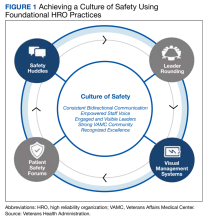Leader Rounding for High Reliability and Improved Patient Safety
Background: Critical to providing safe, effective patient care is ensuring that communication is open and transparent among all members of the health care team. However, current evidence shows that poor communication is commonplace, contributing to medical errors and poor patient outcomes. Implementing leader rounding may improve communication and reliability. The purpose of this initiative was to create an evidence-based process for the implementation of leader rounding for high reliability at the Veterans Affairs Bedford Healthcare System in Massachusetts.
Observations: We conducted a review of medical literature from 2015 to 2022 that found little research specifically related to leader rounding for high reliability. We created a formal and interactive process to improve patient safety by increasing communication among senior leadership, interdisciplinary teams, and frontline staff.
Conclusions: Open, transparent, and bidirectional communication among all staff is critical to improving patient safety and promoting a culture of safety in health care. This initiative may be of value to other health care organizations that are working to improve patient safety. Future efforts will focus on developing a robust evaluation program to explore the impact of leader rounding for high reliability on safety outcomes.
The hospital is altogether the most complex human organization ever devised. Peter Drucker 1
The ever-changing landscape of today’s increasingly complex health care system depends on implementing multifaceted, team-based methods of care delivery to provide safe, effective patient care.2 Critical to establishing and sustaining exceptionally safe, effective patient care is open, transparent communication among members of interprofessional teams with senior leaders.3 However, current evidence shows that poor communication among interprofessional health care teams and leadership is commonplace and a significant contributing factor to inefficiencies, medical errors, and poor outcomes.4 One strategy for improving communication is through the implementation of
We describe the importance of leader rounding for high reliability as an approach to improving patient safety. Based on a review of the literature, our experiences, and lessons learned, we offer recommendations for how health care organizations on the journey to high reliability can improve patient safety.
Rounding in health care is not new. In fact, rounding has been a strong principal practice globally for more than 2 decades.6 During this time, varied rounding approaches have emerged, oftentimes focused on areas of interest, such as patient care, environmental services, facilities management, and discharge planning.4,7 Variations also might involve the location of the rounds, such as a patient’s bedside, unit hallways, and conference rooms as well as the naming of rounds, such as interdisciplinary/multidisciplinary, teaching, and walkrounds.7-10
A different type of rounding that is characteristic of high reliability organizations (HROs) is leader rounding for high reliability. The Veterans Health Administration (VHA) formally launched its journey to becoming an







